Growers concerned about herbicide-resistant wild oat populations should consider testing seed samples to help plan effective control strategies, advise experts.
For this, early July is an ideal time to collect samples once seed has matured, with testing indicating whether herbicide resistance is present, which actives are affected, and also which wild oat species are dominant.
Understanding the resistance status and population profile is essential to determine the best management techniques, cultivations, and herbicide choices, for this very competitive grassweed, says Hutchinsons’ Michael Shemilt.
Where herbicide resistance does occur, like other grassweeds, it can get to unmanageable levels relatively quickly, unless appropriate measures are employed, he warns. “Unlike blackgrass, seeds remain viable in the soil for many years, so there’s always a risk problems re-emerge in the future.”
Resistance risk
Resistance risks are greater in rotations dominated by cereal cropping where there’s more reliance on a limited range of chemistry, he adds.
ADAS resistance testing during the past 13 years shows that where resistance occurs, it’s most likely to be to fenoxaprop, followed by clodinafop, mesosulfuron+ iodosulfuron, and pinoxaden. Recent years have also found some populations resistant to pyroxsulam, but so far, there’s been little resistance to cycloxydim.
While herbicide resistance is a genuine threat, Michael and other experts stress that it remains far less widespread than for other grassweeds, notably blackgrass or Italian ryegrass, and other factors may cause poor control in the field.
In fact, 68% of wild oat samples tested by ADAS were sensitive to herbicides, and in another survey of around 100 samples conducted by NIAB in summer 2020 (sponsored by Life Scientific), 85-90% were susceptible to the key actives pinoxaden and iodosulfuron+ mesosulfuron.
Cross resistance to two types of chemistry at the same time was also very rare, notes Life Scientific’s Ruth Stanley, so even if one type of resistance is confirmed (e.g. to fops and dims), it’s highly likely other types of chemistry (e.g. ALS inhibitors) will still be effective.
Management challenges
Aside from resistance, poor herbicide application or timing is one potential reason for inadequate control in the field, says Ruth. Another factor in recent years is the move away from ALS-inhibiting chemistry (e.g. mesosulfuron+ iodosulfuron) for blackgrass control, due to resistance concerns, she adds.
“Although the efficacy of such chemistry against blackgrass has declined, it was still doing a good job on wild oats, so as people stopped using it, more problems started to appear.”
The focus on blackgrass control and a shift towards minimal tillage systems, may also have contributed to more wild oat issues, especially as the weeds require tackling in different ways, she says.
Collecting seed samples
For resistance testing to work and be as accurate as possible, a good seed sample is essential. NIAB’s John Cussans outlines five key steps:
- Timing: Wait until seed is ripe, with hard endosperm, just like any cereal seed
- Collection: Either run a hand along the inflorescence of the wild oat to gently dislodge seed ready to be shed, or shake heads into a bucket. Don’t strip seed from heads or cut heads off as seed is unlikely to have matured fully
- Quantity: Because of the large seed size in comparison to other weeds, and likelihood of samples including some awns, husk, etc, ideally collect around three coffee mugs to send for resistance testing
- Handling: Store seed indoors in a paper bag or open container for a couple of days, then post in a paper bag
- Results: Results generally take a few weeks to return and will confirm the presence and type of resistance, and the chemistry affected




